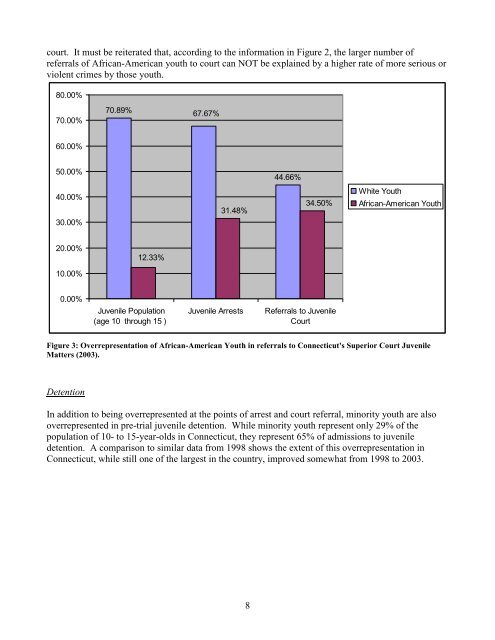Failures in Addressing DMC in Connecticut's Juvenile Justice System
Failures in Addressing DMC in Connecticut's Juvenile Justice System
Failures in Addressing DMC in Connecticut's Juvenile Justice System
You also want an ePaper? Increase the reach of your titles
YUMPU automatically turns print PDFs into web optimized ePapers that Google loves.
court. It must be reiterated that, accord<strong>in</strong>g to the <strong>in</strong>formation <strong>in</strong> Figure 2, the larger number ofreferrals of African-American youth to court can NOT be expla<strong>in</strong>ed by a higher rate of more serious orviolent crimes by those youth.80.00%70.00%70.89%67.67%60.00%50.00%44.66%40.00%30.00%31.48%34.50%White YouthAfrican-American Youth20.00%12.33%10.00%0.00%<strong>Juvenile</strong> Population(age 10 through 15 )<strong>Juvenile</strong> ArrestsReferrals to <strong>Juvenile</strong>CourtFigure 3: Overrepresentation of African-American Youth <strong>in</strong> referrals to <strong>Connecticut's</strong> Superior Court <strong>Juvenile</strong>Matters (2003).DetentionIn addition to be<strong>in</strong>g overrepresented at the po<strong>in</strong>ts of arrest and court referral, m<strong>in</strong>ority youth are alsooverrepresented <strong>in</strong> pre-trial juvenile detention. While m<strong>in</strong>ority youth represent only 29% of thepopulation of 10- to 15-year-olds <strong>in</strong> Connecticut, they represent 65% of admissions to juveniledetention. A comparison to similar data from 1998 shows the extent of this overrepresentation <strong>in</strong>Connecticut, while still one of the largest <strong>in</strong> the country, improved somewhat from 1998 to 2003.8
















